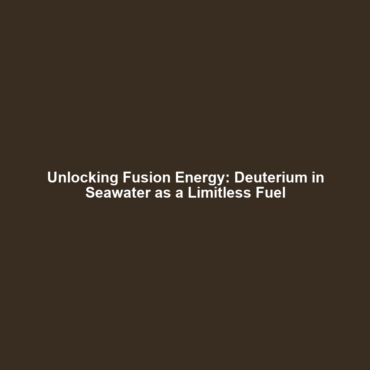Major Milestones: Developments in Magnetic and Inertial Confinement in Fusion Energy
Introduction
The pursuit of fusion energy, a clean and virtually limitless power source, has seen significant advancements in both magnetic confinement and inertial confinement techniques. Major milestones in these areas, including developments in tokamak reactors and projects like the National Ignition Facility, represent critical steps towards harnessing the power of the stars. Understanding these breakthroughs is crucial, as they pave the way for the future of sustainable energy and the resolution of global energy challenges.
Key Concepts
Magnetic Confinement: Tokamak Reactors
Magnetic confinement employs powerful magnetic fields to contain hot plasma, enabling fusion reactions to occur. The tokamak design, originally developed in the Soviet Union, has become the model for most experimental fusion reactors. In this design, plasma is shaped into a toroidal (doughnut) configuration, allowing for stability and high-temperature conditions necessary for fusion.
Inertial Confinement: Laser-Based Systems
Inertial confinement, on the other hand, uses high-energy lasers to compress and heat small pellets of fusion fuel. One of the most notable facilities for this method is the National Ignition Facility (NIF) in California, which aims to achieve ignition—the point at which the energy produced in fusion reactions becomes greater than the energy required to initiate them.
Applications and Real-World Uses
The advancements made in both magnetic confinement and inertial confinement have profound implications for energy production and other fields:
- Power Generation: Both tokamaks and inertial confinement systems are being researched as potential sources of clean energy, which can help reduce reliance on fossil fuels.
- Medical Applications: Techniques developed for plasma manipulation and laser precision in fusion can also enhance cancer treatment through targeted radiation therapy.
- National Security: Research from inertial confinement also plays a part in maintaining the safety of nuclear weapons without nuclear testing.
Current Challenges
Despite the promise of fusion energy, several challenges linger:
- Cost: Developing and maintaining tokamak reactors and facilities like NIF require enormous financial investments.
- Technological Limitations: Achieving and maintaining the extreme conditions necessary for fusion is a significant technical barrier.
- Public Perception: There is often skepticism about the feasibility and safety of nuclear fusion compared to renewable energy sources.
Future Research and Innovations
The future of fusion energy rests on continual research and innovation, including:
- Next-Generation Tokamaks: Projects like ITER (International Thermonuclear Experimental Reactor) aim to demonstrate the feasibility of fusion as a large-scale and carbon-free source of energy.
- Advanced Laser Technology: Improvements in laser technology at facilities like NIF could lead to more efficient inertial confinement methods.
- Private Sector Initiatives: Increasing involvement from private companies is fostering innovative approaches to fusion research, potentially accelerating progress.
Conclusion
The developments in magnetic confinement (tokamak reactors) and inertial confinement (laser-based systems like the National Ignition Facility)underscore the significant strides being made in the field of fusion energy. These innovations hold the promise of delivering sustainable, clean energy to meet future global demands. Continued investment in research and public education about the potential of fusion technology is crucial. For further reading, explore our articles on Fusion Energy Basics and Climate and Energy Solutions.






